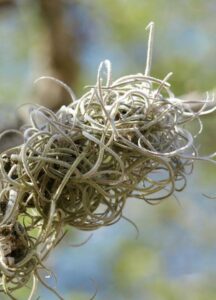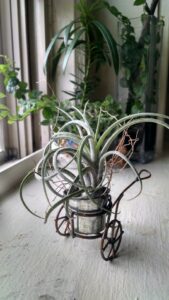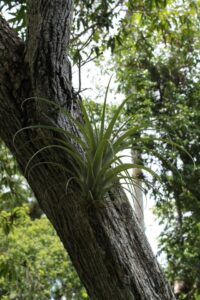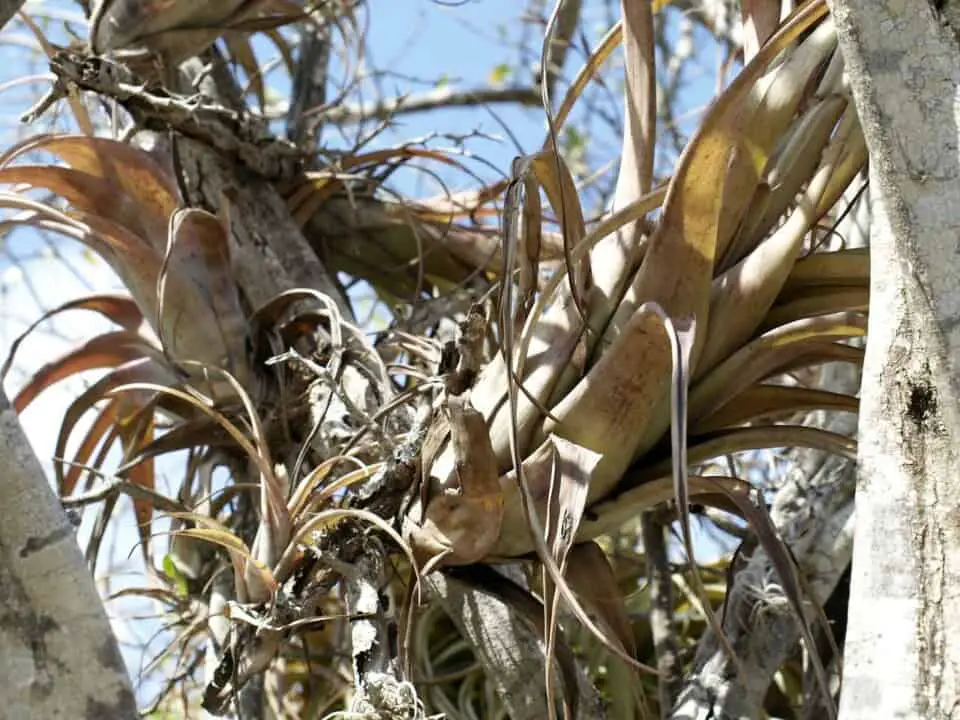Some links in the post are affiliate links and I get a commission from purchases made through some links found in the post.
After successfully planting different species in my home for years, I realized I was running out of space. But I did not want to stop adding more plants.
So, I decided to opt for climbing vines and air plants. How could I go wrong with epiphytic plants that I could mount on the walls?
These beauties did not even need potting mixes, which gave me the flexibility I craved, as my space was now limited.
Thus far, I have not had an issue with air plants but I know that if an air plant is not watered optimally, exposed to bright sun, or left in poor circulation, they could start turning brown.
There are many other reasons why your air plants could turn brown, which I have included in this guide. And all of them are within your control – which is all the encouragement I needed when I brought my first tillandsia (air plant) home:
Why Is My Air Plant Plant Turning Brown?
Most people equate browning to dying. And you are not wrong about that.
Often, it’s a sign that your plant has entered its final stages, whether it’s out of the natural lifecycle or the lack of vital nutrients. I will cover all the probable causes below:
1) Aging
 Plants cannot escape aging any more than humans can. Once your plant has produced flowers, you start noticing changes in its appearance.
Plants cannot escape aging any more than humans can. Once your plant has produced flowers, you start noticing changes in its appearance.
The more the flowers mature, the more the surrounding leaves look brown, more so around their edges.
On the upside, this often precedes the production of pups such that as soon as the old flowers and leaves die off, the new ones take their place.
What to Do About Aging
I’ve tried to delay aging in some cases. But I realized that no matter how much water or fertilizer you offer a plant, you cannot stop what’s inevitable.
If anything, giving your plant too much of anything can damage it, as I will later explain.
Thus, as long as you’re giving the plant enough of what it needs, all you can do is wait out the aging process. The new pups will pave the way for the new plants. And you will still get to enjoy the beauty that is your tillandsia.
You may also like: 8 air plant problems & how to fix them
2) Watering Imbalances
What do most watering issues come down to? – Overwatering and underwatering. And in this case, both could be behind the browning in your air plant.
Underwatering the Air Plant
Air plants derive their moisture from their surroundings. And this makes people think that they can survive long periods without water.
However, this is only true when the air plant grows outdoors where the elements are readily available. Indoors, this is not the case because the conditions are pretty controlled.
Unfortunately, this only denies the plant moisture, leading to underwatering. We all know that plants cannot make enough food to sustain their growth without water.
So, eventually, the air plant starts turning brown as the leaves start dying. So, if you’ve noticed a sudden change in hue, you might want to consider this.
Can You Fix It?
Underwatering is often easy to fix if the plant has not died (yes, that can happen to your tillandsia). All your plant needs is water to promote cellular activities.
So, get some rainwater or filtered water and pour it into a bowl. Then leave the air plant in the water for an hour and allow it to take up the moisture.
Please don’t leave it in for more than two hours because that can create an overwatering issue. Once the time has elapsed, shake the excess water off the plant and leave it to dry before mounting it again.
Overwatering the Air Plant
The other extreme you must consider is overwatering. While your plant does not want to grow without accessing adequate water, it does not want to drown in it either.
And you might think that because you’re only soaking or misting your plant, the moisture does not harm your plant.
But too much misting or soaking damages the plant’s roots, making it harder for the plant to absorb moisture and nutrients.
And without these, it cannot produce food, which results in browning. Note that damaged roots pose a much bigger issue than dehydration. It is always better to underwater than overwater your plant.
An overwatered plant shows more than browning. Other symptoms include:
- Mold on the plant surface,
- A musty smell from the plant, and
- Sogginess/ mushiness in the plant’s leaves and stems.
If you notice such signs, take heed that all is not well. And if you take too long to respond to the apparent overwatering symptoms, the plant could die.
Can You Fix It?
 I’d like to say that fixing overwatering is always an easy task. But that would be a lie. Overwatering can damage the plant roots to the extent that saving the plant is not feasible.
I’d like to say that fixing overwatering is always an easy task. But that would be a lie. Overwatering can damage the plant roots to the extent that saving the plant is not feasible.
So, the first thing you should do is examine the plant for any signs of rotting or moldy growth. If the damage affects more than 80% of the plant’s roots, it’s best to start over by planting another air plant.
The chances of survival are negligible (but not impossible). If the damage is less than 80%, or you want to take a chance on a severely affected air plant, here is what you do:
- Using a sharp and sterilized tool, cut off the damaged plant parts,
- Spray an antifungal treatment on what remains to prevent the spread of mold,
- Leave the plant to dry in a sunny spot where it can get direct sun for about 6 hours a day. Allow it to remain there for two days so it can dry well.
- Move it back to its usual spot,
- Change the plant’s watering regimen, sticking to misting/ soaking it only once weekly.
Only increase the watering frequency if the plant shows signs of underwatering or when the weather gets too hot.
You may also like: How big can an air plant get
3) Exposure to Direct Sunlight
When fixing overwatering in an air plant, exposure to the sun is essential. But this is probably the only time your air plant will ever need such exposure.
Why? There exist more than 500 species of tillandsia. And most of these thrive in bright and indirect sunlight akin to the dappled light they get in their natural habitat.
So, an air plant starts turning brown when you leave them in bright and direct sun, e.g., against a south-facing window.
This exposure robs them of water, dehydrating them and damaging their leaves. That’s when you start noticing browning on the leaf edges as it spreads to cover the entire leaf.
How Much Light Does Your Plant Need?
Your air plant needs bright and indirect light. Even a few hours of direct exposure can damage its leaves.
And sadly, browning on the leaves is not reversible, making it hard for the plant to produce enough food to sustain its growth. To revive your plant and protect it, you should:
- Place it near (not against) an east or west-facing window. Such spots receive bright and indirect light most of the day. And while they may receive direct sunlight for a few hours each day, placing the plant near the windows will protect it from the rays.
- Avoid placing the plant in a north-facing room or other rooms with poor lighting.
Southern-facing rooms are also ideal. But since they receive bright light most of the day, you will need to add sheers to the windows to protect the plant.
You may also like: 4 reasons your air plant is turning yellow
4) Inadequate Air Circulation
What happens when a plant does not have adequate air circulation? I’ll paint a picture. Without enough drafts moving around the plant, humid air tends to accumulate around the plant.
So, the plant starts taking up more and more moisture, just like it would when overwatered. Soon enough, rotting begins.
That’s why you might think that a plant is overwatered, yet the real issue is the air circulation.
Even if you reduce the watering frequency and cut off the damaged parts, the plant will continue rotting unless you deal with the circulation issue.
How To Deal with Poor Air Circulation
The easiest way to deal with circulation is to ensure your plant is in an airy place. I mount mine in the dining area, which has a large window that lets in air and light.
But if you cannot mount your plants, you can house them in open containers. Ensure the mouths are big enough to allow adequate air.
And if you will house your plants in a container, always ensure you dry them after misting/ soaking them before placing them in the container.
Also, do not mist the plant when it is in the container. That only increases the humidity levels, compounding the issue.
5) Underfeeding
 Could your plant be signalling that it needs more fertilizer? This issue is like underwatering.
Could your plant be signalling that it needs more fertilizer? This issue is like underwatering.
It comes down to the thinking that air plants can sustain themselves by absorbing nutrients from the air. And while this is true, it applies outdoors but not indoors.
So, if you leave your plant to fend for itself, it cannot take up enough nutrients to support its growth. The air plant starts turning brown at first before slowly dying. And you need to act fast to save it.
How Should You Feed Your Plant?
The first suggestion would be to leave it outdoors where it can access nutrients as it wishes. But that would rob you of its beauty.
So, the other idea is to get an air plant fertilizer and follow the instructions on the package.
Final Thoughts
Maintaining an air plant is breezy (get it?) If you can get the watering, lighting, and feeding right, your plant will be around for a long time. Happy Gardening!
Before you go, here are some more related articles I encourage you to read below to help solve more of your gardening issues:

